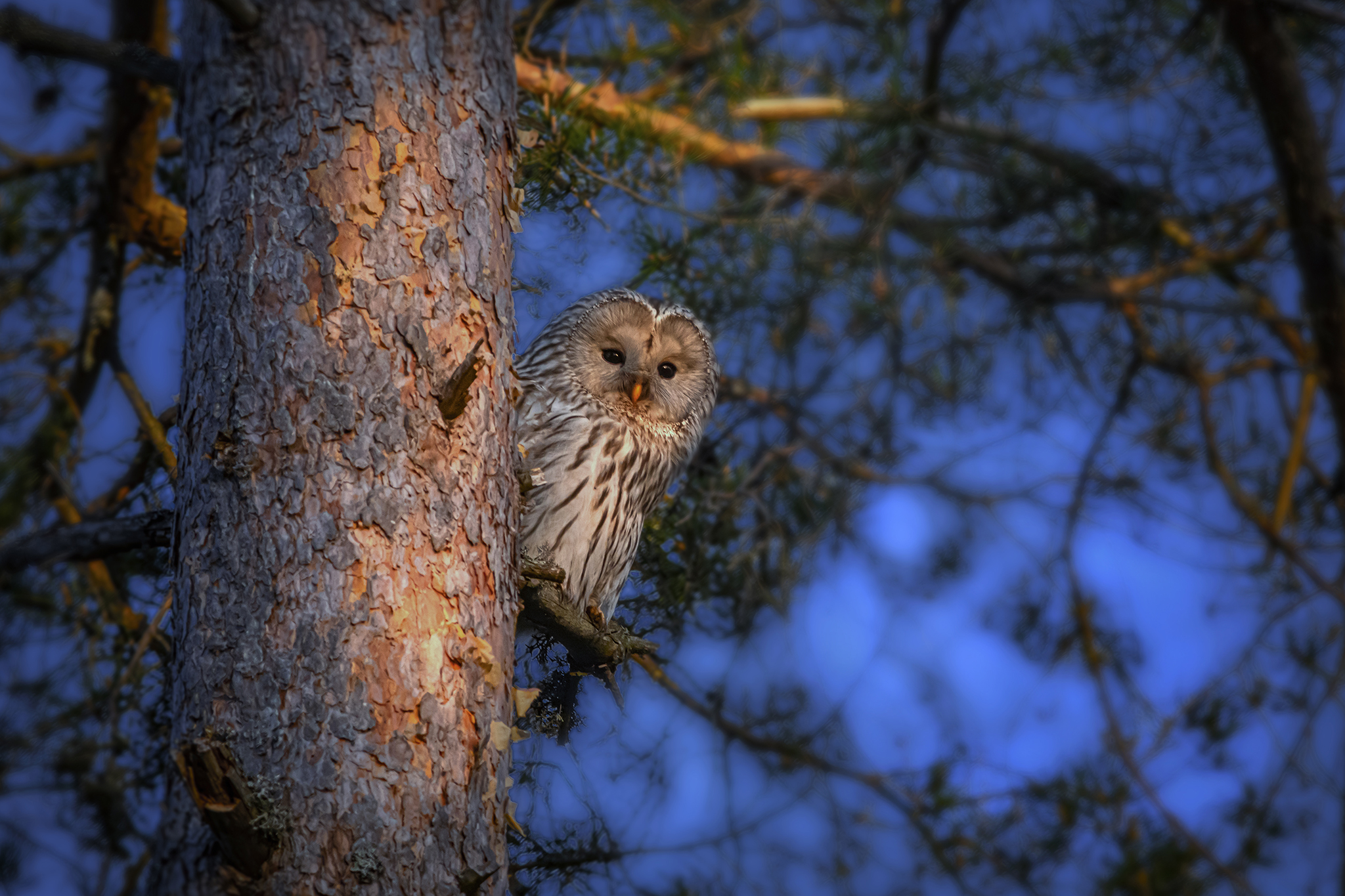Here’s a comprehensive overview of the Ural Owl (Strix uralensis), one of Europe’s most powerful and impressive forest owls. 🦉
🦉 Ural Owl (Strix uralensis)
Scientific name: Strix uralensis Pallas, 1771
Common name: Ural Owl
Family: Strigidae (True Owls)
Genus: Strix
🌍 General Overview
The Ural Owl is a large, pale grey-brown owl native to northern and eastern Europe and parts of Asia.
It is a non-migratory, resident species, occupying mature mixed and coniferous forests with open areas for hunting.
Strong and territorial, the Ural Owl is known for its fearless defense of nesting sites — even attacking intruders, including humans, if they approach too closely.
🧬 Identification
| Feature | Description |
|---|---|
| Length: | 50–62 cm |
| Wingspan: | 110–134 cm |
| Weight: | 500–1300 g (males smaller) |
| Coloration: | Pale grey to brownish-grey, finely streaked with darker markings |
| Facial disc: | Large, rounded, grey-white with darker rim — lacking ear tufts |
| Eyes: | Dark brown (unlike yellow-eyed Tawny Owl) |
| Bill: | Yellowish |
| Tail: | Long and rounded, with fine dark bars (helps distinguish from Tawny Owl) |
| Legs: | Fully feathered to the toes |
| Sexes: | Similar in appearance, female larger |
🪶 Behavior and Vocalization
- Activity: Nocturnal, sometimes crepuscular (active at dawn/dusk).
- Call: Deep, far-carrying hooting — a series of rhythmic notes “hoo-hoo-hoo-hoo-hoo”, slower and more resonant than the Tawny Owl’s.
- Territory: Pairs occupy large territories year-round and defend them fiercely, especially during breeding season.
- Flight: Silent, buoyant, and purposeful; flies with steady wingbeats and long glides.
🌲 Habitat
- Prefers old-growth mixed or coniferous forests with clearings, forest edges, and nearby meadows for hunting.
- Often nests in tree cavities, old raptor nests, or nest boxes.
- Found from lowlands to mountain forests, avoiding treeless tundra and dense urban areas.
🍽️ Diet and Hunting
- Primarily small mammals, especially voles, mice, and shrews.
- Occasionally takes small birds, frogs, or insects.
- Hunts from a perch, swooping down silently on prey located by hearing.
- Plays a crucial ecological role as a rodent population regulator.
🪺 Breeding and Nesting
| Aspect | Details |
|---|---|
| Breeding season: | March–June |
| Nest site: | Tree hollow, old raptor nest, stump cavity, or large nest box |
| Clutch size: | 2–5 eggs |
| Incubation: | ~28–33 days, by female |
| Fledging: | Young leave nest after 27–35 days but remain dependent for weeks |
| Parental care: | Male provides food; female defends nest aggressively |
The female’s defensive behavior is famous — she will dive-bomb potential predators, sometimes striking people who approach nests.
🧭 Distribution
- Europe: Scandinavia, Finland, Baltic States, Poland, Czech Republic, Austria, Balkans, and parts of Central and Eastern Europe.
- Asia: Extends through Russia, Siberia, to northern Japan.
- Altitudinal range: Sea level to ~2000 m in mountain forests.
In Estonia, the Ural Owl is a resident breeder, most common in mature coniferous forests.
📉 Conservation Status
| Category | Details |
|---|---|
| IUCN Red List: | Least Concern (LC) |
| Population trend: | Stable or slightly increasing in many areas |
| Main threats: | Loss of old-growth forests, reduction of nesting cavities, traffic collisions |
| Conservation measures: | Nest box programs, forest management preserving large trees and snags |
🔍 Similar Species
| Species | Key Differences |
|---|---|
| Tawny Owl (Strix aluco) | Smaller, shorter tail, warmer brown tone, yellow eyes |
| Great Grey Owl (Strix nebulosa) | Much larger, with concentric facial rings, smaller eyes |
| Eagle Owl (Bubo bubo) | Ear tufts, orange eyes, much heavier |
🪶 Interesting Facts
- The Ural Owl’s name refers to the Ural Mountains, central to its range.
- During snowy winters, its pale plumage provides excellent camouflage.
- Can live up to 20 years in the wild.
- Its silent flight and strong talons make it a top nocturnal predator.
- Pairs often reuse the same nesting area year after year.
📊 Summary Table
| Trait | Description |
|---|---|
| Scientific name | Strix uralensis |
| Length | 50–62 cm |
| Wingspan | 110–134 cm |
| Weight | 0.5–1.3 kg |
| Eye color | Dark brown |
| Habitat | Mixed and coniferous forests |
| Diet | Small mammals, birds, frogs |
| Breeding months | March–June |
| Clutch size | 2–5 eggs |
| Distribution | N. & E. Europe, Russia, Asia |
| Status | Least Concern |
Views: 1558
Subscribe to the newsletter:
